
ЭкспериментИскусство_2011
.pdf
trum of interpretations (evocative spectrum) in a culturally representative group of people are eventualist artworks.
6)Decay: The evocative spectrum of a stimulus is unstable. It fluctuates if the same stimulus is exposed to different persons and if exposed to the same person at different times. If exposed many times to the same people it causes a smaller and smaller evocative spectrum, because some interpretations tend to prevail over the others and some interpretations tend to go out. When the number of different interpretations reduces, the stimulus decays.
7)Saturation: A stimulus completely decayed is saturated.
When saturated, a stimulus is not different from the common objects of normal reality. A saturated stimulus evokes the same interpretation in anyone.
8)Basic aesthetic concepts of eventualism: Some aesthetic concepts selected from historical avant-garde movements are put together in eventualism. They are: Abstinency of expression, minimality, structurality, spontaneity, interactivity, eventuality and deepness.
9)Abstinency of expression: The artist must аvoid to express
himself and his personal opinion or emotions. He must provoke the spontaneous and involuntary expression of the public with their different and conflictual interpretations.
10) Minimality: Minimality requires taking the shortest and simplest method in the construction of the stimulus and avoiding arbitrary choices. A style identity is not required in eventualism.
Fig. 1. Monochrome Black 77, |
Fig. 2. Typical Gesture: |
1960, 120 × 100 cm., enamel |
J.F. Kennedy, 1962, 150 × 200 cm., |
and paper on canvas |
enamel on canvas |
234
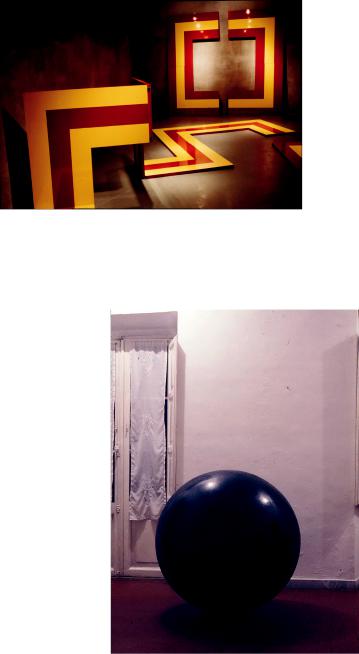
Fig. 3. Super Arrangeable Structure, 1966, 130 × 130 × 5 cm. (each piece), Formica on wood. Create an installation arranging n number of (curve, straight or angled) elements in sequence x, joining each element to the next in one of six possible ways
Fig. 4. Sphere with an Alarm Siren, 1968, diameter 104 cm., mixed media. When moved from position x the sphere emits an alarm signal that can be heard within a range of 800 meters. The signal continues until the sphere is returned to its initial position
235
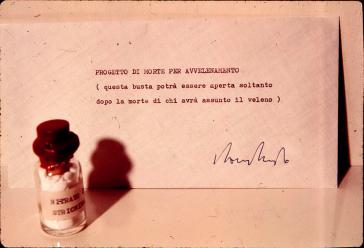
Fig. 5. Project for Death by Poisoning: Nicotin, 1970, bottle and sealed envelope: The envelope is to be opened only after the death of the person who takes the poison
11)Structurality: In constructing the stimulus the artist must work as a scientist, he has to declare in advance his method as to be able to repeat and better the experiment. Structurality is opposite to arbitrary, handicraft, or even inspired creation.
12)Spontaneity: To make evident the expression of the pub-
lic, the stimulus must elicit spontaneity in the public. Pretending spontaneity must be avoided. Undesired errors, breaking a record, dreaming, scientific inventions, non-feigning reactions are examples of spontaneity.
13)Interaction: If the reaction of the public is not uniform, expressive, spontaneous and aesthetically valuable, an eventualist interaction has happened.
14)Eventuality: Eventuality obliges the public unwillingly or
unexpectedly to perform on the level of reality. Such a situation makes each person react in a different, original and spontaneous way.
15) Deepness: This aesthetic concept, not yet completely defined, requires the event to modify the personality of the interacting persons towards new, more complex and more refined cultural ideals.
236
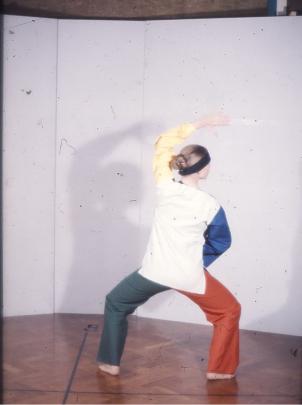
Fig. 6. Concert for a Dancer. 1973. The dancer wears a special uniform: a hat that is white in the right half and black in the left half. A jacket that is white in the back, black in the front, yellow in the right arm and green in the left arm. Each of 10 executants give binary inputs (a,b) to an electronic instrument according to the dynamic positions of the dancer. Only when all the inputs are equal to a binary randomly chosen sequence (unknown to the dancer and to the executants), the instrument gets silent and the concert ends. Before that the instrument emits acoustic frequencies more or less high according to the number of errors guessing the randomly chosen binary sequence. The dancer has only the task to guess, moving his body by trial and error, the position corresponding to the randomly chosen binary sequence. Unwillingly the dancer creates a stochastic music, while trying. Only when the dancer is in the right position does the instrument become silent
237
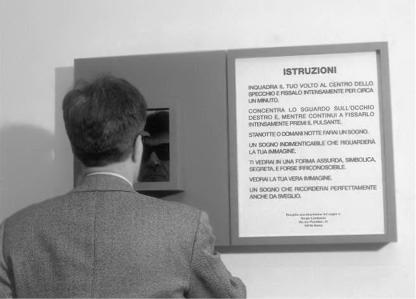
Fig. 7. Tachystoscopic Mirror with Dream Stimulants, 1979,
55 × 90 × 20 cm., a semi-transparent mirror mounted on a wooden box containing an image that is only visible when the box
is illuminated from within. To this end, a flash is located inside the box, to be activated from outside by a button. Near the mirror is the following inscription, giving the public instructions for the mirror’s use: “Position your reflection in the center of the mirror and stare intensely for about a minute. Concentrate on your right eye and, while continuing to stare intensely, push the button.
Tonight or tomorrow night, you will have a dream. An unforgettable dream regarding your image: you will see yourself in an absurd, symbolic, secret form, and perhaps unrecognizable. Your true image will appear to you. An extraordinary and profoundly true self-image.
A dream you will remember even on waking.”
238
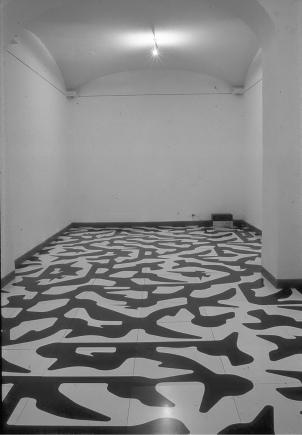
Fig. 8. Stochastic Tiling, 1993, from a set of six minimal drawings a group of 72 stochastic tiles was create by a random deforming program (Lombardo 1986, 1993, 1994; Briguglio et al., 1997). Each tile can be chosen from among 72 tiles and it can combine with the next in four ways.
So a tiling of 40 tiles can be done in 2.375298 ways. In 1996, a stochastic tiling was set up in AAM Gallery in Rome employing only six tiles
239
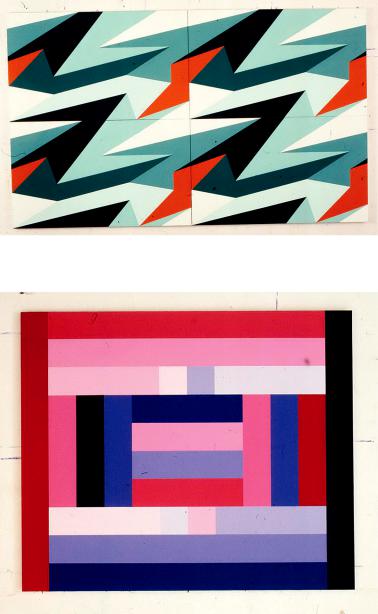
Fig. 9. 7-Chromatic Toroidal Map, 1997, 4 tiles, 60 × 90 cm. each, vinilic on canvas.
Fig. 10. 12-Chromatic Heawood Map, 2001, 100 × 120 cm., vinilic on canvas
240
Roots of the eventualist theory traceable in my artworks since 1960
In 1959 I began to paint Monochromes. I had a skeptical attitude toward art and my aim was to make a painting clearly non-artistic, a painting that everybody could make as well. A painting of no value, lacking in expression, in originality, in preciousness, in fantasy. I glued equal rectangular tiles of paper to the canvas in regular order and enamelled with black. I thought I had done the minimum of artistic creation and I expected that everybody -- artists, critics, art dealers -- would recognize such an object as a simple object, not as a work of art. Actually I wanted to make an object which was to be perceived as evidently non-art. But in some contradiction with my aim and expectations, I liked the result and I made more objects with the same procedure (see Fig.1). In 1962 some of these objects were accepted in official art exhibitions (Bucarelli, 1962; Ponente, 1962; Ponente, 1975; Mirolla, 1994). A posteriori I became aware of the theory of expression abstinency: The artist must not express himself, the art work is only a stimulus to make evident the expression of the public (Lombardo 1979b, 1987, 1997b).
Suddenly, without any apparent connection to the previous paintings, in 1961 I began to paint the Gesti Tipici (Lombardo,1963; Homberg ,1980; Staël, 1990; Calvesi, Mirolla, 1995). The silhouettes of important politicians like J.F.Kennedy, Mao Tse-tung, Nikita Khrushchev, Charles De Gaulle were enamelled in black, the size larger than reality. The images were cut in very suggestive and authoritative attitudes in order to make viewers uneasy. Many visitors told me they dreamt the Gesti Tipici for weeks. Afterwards I understood how to make people dream (Lombardo 1979, 1981). Now I can see the ties of the Gesti Tipici with Monochromes and with the eventualist theory: black enamel as industrial and non expressive paint (expression abstinency), lack of details (minimality), a mechanical method of construction of the painting (structurality), which became a stimulus for the visitors to dream (spontaneous expression of the public), the visitors feeling obliged to perform uneasiness on the level of reality (eventuality).
In 1965 my work was considered in the international area of Pop Art (Halloway, 1965; Lippard ,1966; Solomon ,1968; Kultermann, 1969; Becker et al., 1999; De Martiis, 1999; Christov-Bakar- giev, 2001), but I got bored again and I began to construct very minimalistic environments using sharp geometric forms covered with
241
formica (Homma et al. 1967; Bucarelli ,1967, Boatto,1967; Volpi, 1968; Solomon, 1968; Kultermann, 1969; Ponente, 1974; Calvesi et al., 1995). Extra Points are black plastic points to be fixed on the white walls of a room according to a program created by the public “Arrange a number N of points within the space X according to plan Y”. Some boxes had to be filled with colored cubes but the task given to the public was not plain: “Fill a box that will hold 20 cubes perfectly, having 21 cubes available, 7 red, 7 yellow and 7 blue”. In another room a Super Arrangeable Sculpture was to be constructed by the public: “Arrange n number of equal elements in sequence x, joining each element to the next in one of six possible ways”. Such elements could be straight, curved or angled. The Super Arrangeable Sculpture (see Fig. 3) was exhibited in 1968 at the Jewish Museum in New York and at the Institute of Contemporary Art in Boston. Alan Solomon, the art critic who conquered Europe at the Biennale of Venice in 1964 with American Pop Art, was the curator of the exhibitions. Perhaps for political reasons that I do not understand (Paterson, 1979; Cockroft, 1974, Eudes, 1982; Guilbaut, 1983), the exhibition was completely demolished by the critic of the New York Times (Canaday, 1968). In any case, several eventualist concepts can be found in this work: interaction with the public (interactivity), industrial construction of the stimulus (structurality), minimal forms (minimality), no arbitrary choice of the artist (expression abstinency), the difficult task given to the public to aesthetically arrange, or to solve, a problem, or to give personal interpretations (eventuality).
In 1968 the main problems I was dealing with were: eventuality, spontaneity and interactivity. Minimality, structurality and expression abstinency were already clear to me and deepness was not yet a problem. I wanted to create a surprising situation in which the visitor of the exhibition had to find himself in the role of actor even if at first he had come in the role of spectator. To this end, I would create an emergency situation. I constructed a sphere which, when moved from a position X, emits an alarm signal that can be heard within a range of 800 metres. The alarm signal can stop only if the sphere is returned exactly to its initial position. The object (see Fig. 4) was exhibited in Rome at the Galleria La Salita and at the Sixième Biennale de Paris in 1969, and at the Biennale di Venezia in 1970. The variation of critics’ interpretations was extremely wide. I was satisfied with it, but what disappointed me was the trivial superficiality of some customary visitors. After the first days of surprise,
242
some visitors came back many times only to play with the spheres. Some women came with children and some photographers came with models to take pictures for advertising work. Perhaps on that occasion I felt the necessity of deepness and the necessity of a more careful attitude on the part of visitors. Moreover, on that occasion, I had a very clear idea of the decay of events. To solve such problems I exhibited the Project for Death by Poisoning (Galleria La Salita, Roma 1970; Academy of Fine Arts, Wien 1970; Galleria Paramedia, Berlin 1971; Galleria Christian Stein, Torino 1971), a work that makes interaction very serious and dangerous. A bottle of raw nicotine lies near a sealed envelope, on the envelope is written: “This envelope is not to be opened before the death of the person who takes the poison” (see Fig. 5). After 1971 the interaction became less free, rules of interaction were made and the space of the gallery became a scientific laboratory. The Concerts for Actions were done in my studio and in some art galleries from 1971. I wanted spontaneous behavior, difficult interactions in a game in which people had to open themselves to the real risk of failure (eventuality). The task was to guess the right facial expression, the right phrase to pronounce, the right body position to assume and so on (Lombardo 1972, 1972b, 1980; Ponente, 1974; De Marchis, 1976). Here, only the Concert for a dancer is considered (see Fig.6). The aim of the dancer is to stop the music, not to be expressive. Unwillingly the dancer is very expressive because she fails to get the right position. What makes her expressive is the effort, the attempt to solve a problem and the failure in getting rid of it. The mistakes she makes are spontaneous (Lombardo,1986) and pertaining to the range of reality (eventuality), not to the range of artistic representation.
My studio became more and more similar to a scientific laboratory of experimental psychology. To join experimental research and art exhibition activity, in 1977 the Jartrakor Association was founded. To publish experimental results and theories, in 1979 the Rivista di Psicologia dell’Arte was founded.
In laboratory activities, I investigated suggested dreams, formal algorithms generating random pictures and subliminal perception. Sometimes I made use of a box with a semi-transparent mirror through which an image could be seen when illuminated from within by a photographic flash. The time of illumination was too short to have consciousness of the image, but the image so given affected the person in various ways. Otto Pözl (1917) discovered that images presented in tachistoscopically, and not identified, reappeared
243
